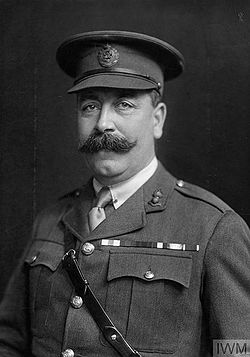Shergold, Charles J
| Charles J. Shergold | |
|---|---|
| 8 April 1970 – 13 August 1947 | |
 | |
| Place of birth | Portsea Portsmouth, Hants, England |
| Place of burial | Prospect Cemetery, Toronto |
| Allegiance | Canada |
| Service/branch | Canadian Army |
| Rank | Lieutenant-Colonel |
| Awards | MC, DCM |
Early Life
Charles was born at Portsea Portsmouth in Hants, England on 8 April 1870. He was an orphan child raised by James (1840 - 1911) and Louisa (1846-1902) Shergold.[1]
Service
Charles joined the Royal Engineers on 8 June, 1888 at the age of 18. He served in the South African War from 1899 to 1902, seeing action at the Relief of Kimberly, Paardeburg, Dreifontein, and Belfast. In addition to the Queens South Africa medal with these clasps he received the Kings South Africa medal as well. In 1903-4 he saw service in the Gold Coast Colony but did not receive any medal for his service in that theatre.[2][3]
In 1905 when the Canadian Government agreed to take over responsibility for Halifax and Esquimalt, there was an increase in the tasks of the Royal Canadian Engineers. The establishment was increased and, as qualified men were not immediately available in Canada, members of the Royal Engineers filled the gap. Officers were on loan but the other ranks, one of which was Charles Shergold, were transferred to the Royal Canadian Engineers.[4] In 1906, after 18 years service with the Royal Engineers, he emigrated to Canada[5] and was made RSM Royal Canadian Engineers holding the position of instructor in military engineering and telegraphy. He was awarded his army Long Service and Good Conduct medal in June of the same year.[2]
Records of his service between 1906 and the Great War haven't been located but is is known that in April and May 1910, Charles attended a School of Signalling where he earned his Assistant Instruction certificate. At the outbreak of the First World War, Company Sergeant-Major Shergold was attending a wireless-telegraph course in England. He proceeded to the front on 16 August 1914 with 1 Signal Company, Royal Engineers, the unit to which he was attached[6] where he took part in the retreat from Mons, the battles of the Marne and the Aisne, the first and second battles of Ypres and Neuve Chapelle. He distinguished himself with the Signal Service and, in addition to being granted a commission as a Temporary Second Lieutenant in the Royal Engineers effective 21 October 1914[7], he was awarded the Military Cross[8], the Distinguished Conduct Medal[9] and was twice Mentioned in Despatches[10][11]. For serving under fire in France and Belgium prior to 22 November 1914 he received the 1914 Star with bar.
In July 1915, he transferred back to the Royal Canadian Engineers and assumed command of the Canadian Engineering Training Depot (Signals)[12], later the Signals Wing of the Canadian Engineer Training Depot, in England. He was made an Honorary Captain while serving with the Canadian Expeditionary Force.[13] He served as the Commanding Officer until December 1915 when he was replaced by Major Lister. He again served as the Commanding Officer as a Temporary Major from 1 June until 29 November 1917. He once again was recognized for his valuable service and was brought to notice of the Secretary of State for War.[14]
In May 1918 he was transferred to the 1st Engineer Reserve Battalion where he served as both Second-in-Command and Officer Commanding until returning to Canada in December 1918. He continued to serve in the Royal Canadian Engineers and saw service as Officer Commanding at Camp Petawawa. He retired in 1930 at the rank of Lietenant-Colonel.[1]
Distinguished Conduct Medal
The citation for Sergeant-Major Shergold's DCM reads:[9]
- For exceptional coolness and resource under a heavy shellfire at Tour de Paissy, on 18th September.
Personal Life
Charles married Emily Charlotte Robinson (1873 - 1976) on 24 March 1894. Together they had three daughters, Louisa in 1894, Ethel May in 1896 and Dorothy in 1905, and one son, Sydney Charles in 1897.[12]
He died on 13 August 1947 and is buried at Prospect Cemetery in Toronto.[15]
Related Pages
- No related pages at this time
Related Items
References and Notes
- ↑ 1.0 1.1 Michael Long, great-grandson of Charles Shergold.
- ↑ 2.0 2.1 Capt. Andrew B. Godefroy. ‘An Early Award? A Canadian DCM Mystery Solved’, Journal of the Military Collector’s Club of Canada. 197 (Summer 1999), 55-59.
- ↑ The Canadian Sapper, Official Magazine of the Canadian Engineers, May 1918, Vol. 1 No. 4, page 109.
- ↑ Colonel A.J. Kerry and Major W.A. McDill. The History of the Corps of Royal Canadian Engineers Volume I 1749-1939. The Military Engineers Association of Canada, Ottawa 1962, 54.
- ↑ 1911 Census of Canada, Library and Archives Canada.
- ↑ Semaphore to Satellite, page 30.
- ↑ The London Gazette, Supplement 28968. 9 November, 1914. Page 9111.
- ↑ The London Gazette, Supplement 29024. 29 December, 1914. Page 8.
- ↑ 9.0 9.1 The London Gazette, Supplement 29009. 15 December, 1914. Page 10789.
- ↑ The London Gazette, Supplement 29001. 8 December, 1914. Page 10534.
- ↑ The London Gazette, Supplement 29422. 31 December, 1915. Page 73.
- ↑ 12.0 12.1 Service File, Library and Archives Canada.
- ↑ The London Gazette, Supplement 29307. 24 September, 1915. Page 9434.
- ↑ War Office Communique, 24 February, 1917. This was somewhat similar to a Mentioned in Despatch award but was for service other than in the presence of the enemy.
- ↑ Lt-Col Shergold at BillionGraves.com




